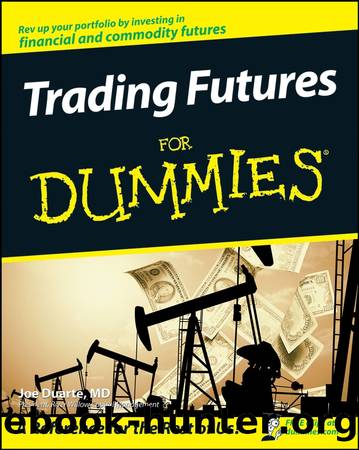Trading Futures for Dummies by Joe Duarte

Author:Joe Duarte [Duarte, Joe]
Language: eng
Format: epub
Tags: Business & Economics, Insurance, Risk Assessment & Management, political science, Public Affairs & Administration
ISBN: 9780470287224
Google: BCDKsgEACAAJ
Publisher: Wiley
Published: 2008-07-08T00:20:19.826523+00:00
Hedging in general terms
In general, hedging is taking a position in the market thatâs in the opposite direction of a trading position youâve already established; itâs a form of insurance against a reversal of trends. You need to know what the opposition is doing anyway so that youâre better able to make your market move. In the world of short-term interest rates, aside from speculators, the big money comes from money-market funds and corporations.
Generally, money-market fund managers and corporate traders go long or short in the direction thatâs opposite their borrowing or lending. Borrowers generally want to hedge against rising interest rates, so they tend to short the market. That way, if interest rates rise, they either reduce their future interest-rate costs or actually profit from the situation.
Money-market funds and corporations borrow and lend millions of dollars on a daily basis, so the short-term interest-rate market, especially in Eurodollars and related contracts, is the way they hedge their exposure. Hereâs how hedging works for the various participants:
Lenders: Banks and other lending institutions want to hedge against falling interest rates, so they tend to be long on the market. They know that theyâll be lending money to someone in the future, and if interest rates continue to fall, their profits will be reduced accordingly. By using futures strategies, they lessen the impact of having to charge less interest and thus help curtail potential future losses.
Institutions decrease their risk when they sense that rates are going to fall by establishing long positions in bonds, T-bills, or Eurodollar futures contracts in order to protect their future earnings. The money that they make when they sell their contracts goes to the bankâs bottom line, balancing revenue lost from lending to customers at lower interest rates. This strategy is by no means perfect, but if the institution does it correctly, it at least cushions the blow.
Corporate treasurers: These big-money institutions use sophisticated formulas based on the need to protect their cash flow and future expenses. They also hedge against the risk of adverse international and geopolitical events and against nonpayment by high-risk customers by using the short- and long-term interest-rate futures markets.
For example, say youâre the chief financial officer at an international paper products company that has multiple risks, such as the price of lumber and pulp to make paper and related products and a large customer base in Latin America, meaning that political instability is a major factor you must consider when running your business. By using lumber futures and currency hedges and by varying your strategies based on market conditions and analysis, you can decrease the risk of material shortages and political instability to your companyâs earnings.
Speculators: Traders just like you and me always want to trade with the trend, which is why technical analysis (see Chapter 7) is so helpful in futures trading. By the time a tick is printed on a chart, itâs as good of a snapshot as there is for all hedging and speculating that has taken place up to that instant in time.
Download
This site does not store any files on its server. We only index and link to content provided by other sites. Please contact the content providers to delete copyright contents if any and email us, we'll remove relevant links or contents immediately.
Zero to IPO: Over $1 Trillion of Actionable Advice from the World's Most Successful Entrepreneurs by Frederic Kerrest(4288)
Machine Learning at Scale with H2O by Gregory Keys | David Whiting(4176)
Never by Ken Follett(3788)
Harry Potter and the Goblet Of Fire by J.K. Rowling(3773)
Ogilvy on Advertising by David Ogilvy(3508)
Shadow of Night by Deborah Harkness(3302)
The Man Who Died Twice by Richard Osman(2996)
Book of Life by Deborah Harkness(2867)
The Tipping Point by Malcolm Gladwell(2827)
Will by Will Smith(2791)
0041152001443424520 .pdf by Unknown(2784)
My Brilliant Friend by Elena Ferrante(2773)
How Proust Can Change Your Life by Alain De Botton(2742)
Purple Hibiscus by Chimamanda Ngozi Adichie(2649)
How to Pay Zero Taxes, 2018 by Jeff A. Schnepper(2602)
Hooked: A Dark, Contemporary Romance (Never After Series) by Emily McIntire(2496)
Rationality by Steven Pinker(2291)
Borders by unknow(2227)
Can't Hurt Me: Master Your Mind and Defy the Odds - Clean Edition by David Goggins(2225)
